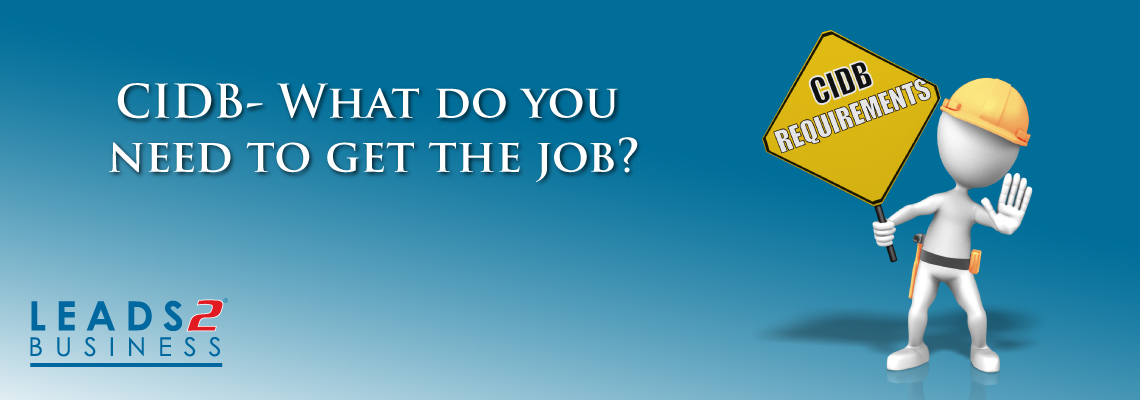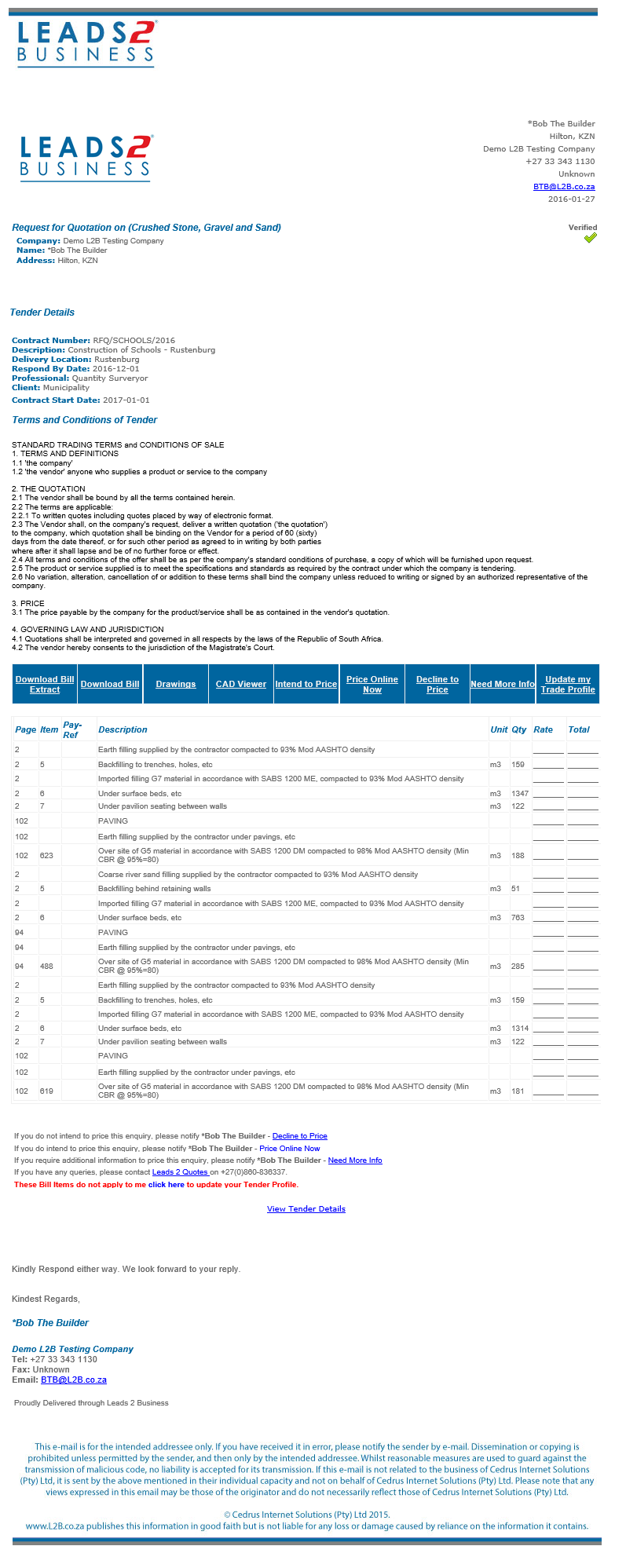What do you need to get the job?

The Construction Industry Development Board (cidb) – a Schedule 3A public entity – was established by Act of Parliament (Act 38 of 2000) to promote a regulatory and developmental framework that builds:
- Construction industry delivery capability for South Africa’s social and economic growth.
- A proudly South African construction industry that delivers to globally competitive standards.
The cidb’s focus is on
- Sustainable growth, capacity development and empowerment
- Improved industry performance and best practice
- A transformed industry, underpinned by consistent and ethical procurement practices
Enhanced value to clients and society
Construction companies is South Africa are required to register with the CIDB for various classes of construction works, if they want to be awarded Government tenders, and are assigned ratings based on their financial capability. CIDB ratings, when required, are listed on tender notices and perform two functions: The most obvious being that if a company is not registered in that particular rating or class of work then that company can not be awarded that contract (unless they form a Joint Venture); and the second is that the Rating gives a estimated value for the contract concerned. This is helpful for subcontractors to determine whether it is worth their while to approach those companies tendering.
Below is a breakdown of the various Construction works and how the various ratings are determined:
Class of Construction Works
GB General Building
CE Civil Engineering
EB Electrical Engineering Works – Building
EP Electrical Engineering Works – Infrastructure
ME Mechanical Engineering
SB Asphalt works (supply and lay)
SC Building Excavations, shaft sinking, lateral earth support
SD Corrosion protection (cathodic, anodic and electrolytic)
SE Demolition and blasting
SF Fire prevention and protection systems
SG Glazing, curtain walls and shop fronts
SH Landscaping, irrigation and horticulture works
SI Lifts, escalators and travellators (installation, commissioning and maintenance)
SJ Piling and specialised foundations for building and structures
SK Road markings and signage
SL Structural steelwork fabrication and erection
SM Timber buildings and structures
SN Waterproofing of basements, roofs and walls using specialist systems
SO Water supply and drainage for buildings (wet services, plumbing)
SQ Steel security fencing or precast concrete
Class of Construction Works
Civil Engineering (CE): Construction Works primarily concerned with materials such as steel, concrete, earth and rock and their application in the development, extension, installation, maintenance, removal, renovation, alteration, or dismantling of building and engineering infrastructure.
Basic Work Types: Water, sewerage, roads, railways, harbours and transport, urban development and municipal services.
Examples: Structures such as cooling tower, bridge culvert, dam, grand stand, road, railway, reservoir, runway, swimming pool, silo or tunnel. The results of operations such as dredging, earthworks and geotechnical processes. Township services, water treatment and supply, sewerage works, sanitation, soil conservation works, irrigation works, storm-water and drainage works, coastal works, ports, harbours, airports and pipelines.
Electrical Engineering Works – Building (EB): Construction Works that are primarily concerned with the installation, extension, modification or repair of electrical installations in or on any premises used for the transmission of electricity from a point of control to a point of consumption, including any article forming part of such an installation
Basic Work Types: All electrical equipment forming an integral and permanent part of buildings and/or structures, including any wiring, cable jointing and laying and electrical overhead line construction.
Examples: Electrical installations in buildings. Electrical reticulations within a plot of land (erf) or building site. Standby plant and uninterrupted power supply. Verification and certification of electrical installations on premises.
Electrical Engineering Works – Infrastructure (EP): Construction Works that are primarily concerned with development, extension, installation, removal, renovation, alteration or dismantling of engineering infrastructure: a) relating to the generation, transmission and distribution of electricity; or b) which cannot be classified as EB.
Basic Work Types: Electrical power generation, transmission, control and distribution equipment and systems
Examples: Power generation. Street and area lighting. Substations and protection systems. Township reticulations. Transmission lines
General Building Works (GB): Construction Works that: a) are primarily concerned with the development, extension, installation, renewal, renovation, alteration, or dismantling of a permanent shelter for its occupants or contents; or b) cannot be categorised in terms of the definitions provided for civil engineering works, electrical engineering works, mechanical engineering works, or specialist works.
Basic Work Types: Building and ancillary works other than those categorised as: Civil engineering works; Electrical engineering works; Mechanical engineering works; Specialist works.
Examples: Buildings for domestic, industrial, institutional or commercial occupancies. Car ports. Stores. Walls.
Mechanical Engineering Works (ME): Construction Works that are primarily concerned with the development, extension, installation, removal, alteration, renewal of engineering infrastructure for gas transmission and distribution, solid waste disposal, heating, ventilation and cooling, chemical works, metallurgical works, manufacturing, food processing and materials handling.
Basic Work Types: Machine systems including those relating to the environment of building interiors. Gas transmission and distribution systems. Pipelines. Materials handling, lifting machinery, heating, ventilation and cooling, pumps. Continuous process systems, chemical works, metallurgical works, manufacturing, food processing such as that in concentrator machinery and apparatus, oil and gas wells, smelters, cyanide plants, acid plants, metallurgical machinery, equipment and apparatus, and works necessary for the beneficiation of metals, minerals, rocks, petroleum and organic substances or other chemical processes.
Examples: Air-conditioning and mechanical ventilation. Boiler installations and steam distribution. Central heating. Centralised hot water generation. Compressed air, gas and vacuum installations. Conveyor and materials handling installations. Continuous process systems involving chemical works, metallurgical works, oil and gas wells, acid plants, metallurgical machinery, equipment and apparatus, and works necessary for the beneficiation of metals, minerals, rocks, petroleum and organic substance and other chemical processes. Dust and sawdust extraction. Kitchen equipment. Laundry equipment. Refrigeration and cold rooms. Waste handling systems (including compactors)
Specialist Works
SB: The extension, installation, repair, maintenance or renewal, or removal of asphalt.
SJ: The development, installation, removal, or dismantling, as relevant, of piles and other specialised foundations for buildings and structures.
SC: The development, extension, installation, removal and dismantling, as relevant, associated with building excavations, shaft sinking and lateral earth support.
SK: The installation, renewal, removal, alteration or dismantling, as relevant, of road markings and signage.
SD: The development, extension, installation, repair, renewal, removal or alteration of corrosion protection systems (cathodic, anodic and electrolytic).
SL: The development, extension, installation, renewal, removal, renovation, alteration or dismantling of structural steelwork and scaffolding.
SE: Demolition of buildings and engineering infrastructure and blasting.
SM: Timber buildings and structures.
SF: The development, extension, installation, renewal, removal, renovation, alteration or dismantling of fire prevention and protection infrastructure (drencher and sprinkler systems and fire installation).
SN: The extension, installation, repair, maintenance, renewal, removal, renovation or alteration, as relevant, of the waterproofing of basements, roofs and walls using specialist systems.
SG: The development, extension, installation, renewal, removal, renovation, alteration or dismantling of glazing, curtain walls and shop fronts.
SO: The development, extension, installation, renewal, removal, alteration, or dismantling or demolition of water installations and soil and waste water drainage associated with buildings (wet services and plumbing).
SH: The development, extension, installation, maintenance, renewal, removal, alteration or dismantling, as relevant, of landscaping, irrigation and horticultural works.
SQ: The development, extension, installation, repairs, dismantling of precast walls, installation of wire perimeter fencing, diamond perimeter fencing, palisade steel fencing with posts and stay at intervals.
SI: The development, extension, installation, repair, maintenance, renewal, removal, renovation, alteration or dismantling of lifts, escalators, travellators and hoisting machinery
How contractor grading designations are determined
Your contractor grading designation is determined by your financial capability and your works capability.
Your financial capability relates to your financial history (turnover), and the amount of working capital you can muster to sustain a contract, i.e. available capital. Available capital is the sum of total equity, retained income, shareholders or member’s loans and any form of acceptable financial sponsorship.
Your works capability is determined by the largest contract you have undertaken and completed in your class of construction works (completed during the 5 years immediately preceding the application).
Your contractor grading designation will be used by Government (national, provincial, municipal and state owned enterprises) to qualify your tender to be considered for a particular construction works contract. For example: if you are registered as a 5CE, you will be considered for public sector civil engineering works contracts of a value not exceeding R6.5 million. You may register for different classes of works, for example, you may be registered as a 5CE and as an 8ME. This means that you will also be considered for public sector mechanical engineering works contracts of a value not exceeding R130 million.
Determining Financial Capability
The specific requirements that need to be satisfied in respect of the contractor grading designation being applied for, depending on the contractor grading designation applied for, the financial capability will be determined from:
- the best turnover from the two financial years immediately preceding the application;
- the available capital that you are able to mobilise;
- the contractor must satisfy all the criteria relating to financial capability.
Determining Works Capability
The specific requirements that you need to satisfy in respect of the contractor grading designation applied are:
Designation
Grade 2: Must have completed a contract with the value of not less than R130 000.
Grade 3: Must have completed a contract with the value of not less than R450 000 and either have best turnover not less than R1 000 000 or have available capital not less than R100 000.
Grade 4: Must have completed a contract with the value of not less than R900 000 and either have best turnover not less than R2 000 000 or have available capital not less than R200 000.
Grade 5 and higher: Must have works and financial capability not less than that tabulated in Table C(i) below, for the contractor grading designation applied for.
Determining Financial Capability
Potentially Emerging Enterprises
A registered, potentially emerging contractor may be awarded a contract at one level higher than the enterprise’s registered contractor grading designation, if the client or employer:
Is satisfied that such a contractor has the potential to develop and qualify to be registered in that higher grade; and
Ensures that financial, management or other support is provided – in the context of a targeted development programme
- to enable the contractor to successfully execute that contract.
Joint Ventures
A joint venture is a grouping of two or more contractors who jointly undertake to perform a construction works contract.
Any enterprise that tenders or enters into a contract for construction works with the public sector, must be registered.
Once-off joint ventures do not have to register. Each partner of the joint venture must be separately registered and the lead partner must have a contractor grading designation not lower than one level below the required grading designation in the class of construction works under consideration.
The contractor grading designation for a once-off joint venture is assessed by the client, based on:
the sum of the best annual turnover of all the members of the joint venture;
the sum of the available capital of all the members of the joint venture; and
The cidb has developed a calculator to enable assessment of joint ventures. This calculator is available on the cidb website at www.cidb.org.za
Leads 2 Business subscribers have the option to filter by CIDB ratings as well as set up their Advisory settings, so they only receive the Ratings that they are interested in. My advice in this regard, would be to go “one above and one below”. The idea of the CIDB ratings is progression. New companies start out with a CIDB 1 and as the company grows in experience and financial standing, they would progress up the ratings. So a subscriber would select “one above” (as in a Rating above their current Rating) and select “one below” to make sure that they are notified of any tenders where only the PE (Potentially Emerging) rating has been specified on the tender. Keeping an eye on the next rung up the ladder, but ensuring your foot is still firmly in place on the rung below (if you like metaphors).
Examples of tender notices of various CIDB Ratings and Classes:
cidb HELPLINE | 086 100 2432 | CIDB
If you are interested in becoming one of our subscribers, please visit our website.
To view notes with screenshots on how to use our website, please visit our Wiki site.
To view more articles, please visit our blog.
I started working at Leads 2 Business in February 2005, and have served as Head of Department of Daily Tenders from 2007 until the present. I oversee both the Daily Tenders South Africa and Africa Departments.














